Edmondson Psychological Safety Guide: Unlocking Workplace Trust 2025
Imagine stepping into a workplace where every idea matters, mistakes spark growth, and trust is the engine for innovation. This is the promise at the heart of edmondson psychological safety—a concept that’s transforming how organizations function in 2025.
In this guide, we’ll explore Amy Edmondson’s Psychological Safety framework, showing how it enables leaders and teams to build high-performing, resilient workplaces. You’ll discover practical steps rooted in research to foster trust, accountability, and open communication.
Get ready to unlock the keys to workplace trust. We’ll define psychological safety, examine its impact, break down Edmondson’s proven approach, tackle common challenges, and share actionable strategies you can use now.
What is Psychological Safety? Edmondson’s Definition and Evolution
Psychological safety is transforming how teams work and lead. The concept, known widely as edmondson psychological safety, is now a cornerstone for organizations seeking innovation, trust, and resilience. To understand its power, we must explore its origins, key elements, and clear up common misconceptions.
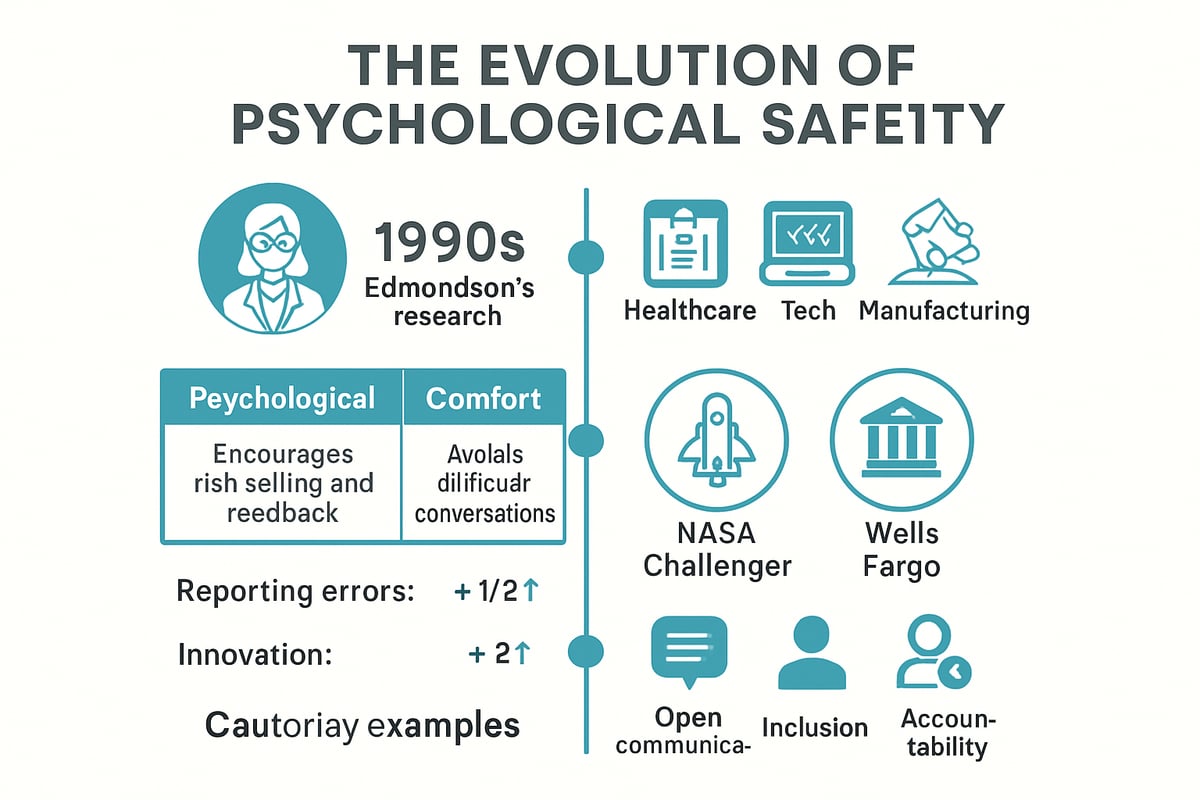
The Origins of Psychological Safety
The journey of edmondson psychological safety began in the 1990s with Amy Edmondson’s research at Harvard Business School. Her studies revealed a surprising pattern: high-performing teams did not hide their mistakes but reported more errors. This counterintuitive finding showed that these teams were not less competent, but more open and willing to admit mistakes.
Edmondson defined psychological safety as a shared belief that a team is safe for interpersonal risk-taking. The focus shifted from comfort to the freedom from fear of ridicule or retaliation. As Edmondson’s work gained traction, psychological safety moved beyond healthcare and became vital in technology, finance, and manufacturing.
For those interested in Edmondson’s foundational research, her original study, Psychological Safety and Learning Behavior in Work Teams, remains a landmark reference.
Core Elements of Psychological Safety
Edmondson psychological safety is built upon several core elements that foster learning and innovation:
- Open communication: Team members are encouraged to ask questions, raise concerns, and voice dissenting opinions.
- Admitting mistakes: Errors are reframed as opportunities for growth and learning.
- Inclusion: Every voice, regardless of rank or background, is valued.
- Accountability: High standards are maintained alongside psychological safety.
As Amy Edmondson famously said, “Speaking up is heroic. It’s the right thing to do … it saves lives.” The tragic NASA Challenger disaster and the Wells Fargo scandal both highlighted what can happen when psychological safety is absent. In both cases, the cost of silence was catastrophic.
Misconceptions and Clarifications
Despite its growing popularity, edmondson psychological safety is often misunderstood. It is not about being nice or creating a comfort zone. Teams can disagree passionately and still be psychologically safe. In fact, healthy debate is a sign of safety, not conflict.
Importantly, psychological safety does not excuse poor performance or a lack of accountability. It creates the space for honest feedback and continuous improvement. Studies show that teams with high psychological safety significantly outperform their peers in innovation and error reduction.
To successfully foster edmondson psychological safety, organizations must clarify these distinctions and build cultures where trust and accountability thrive.
The Business Case: Why Psychological Safety Matters in 2025
Imagine a team where everyone feels safe to share bold ideas, admit mistakes, and challenge the status quo. This is not just a workplace ideal—it is the foundation for high performance in the modern era. The edmondson psychological safety framework is more than a feel-good concept; it is a business-critical driver for organizations aiming to thrive in 2025 and beyond.
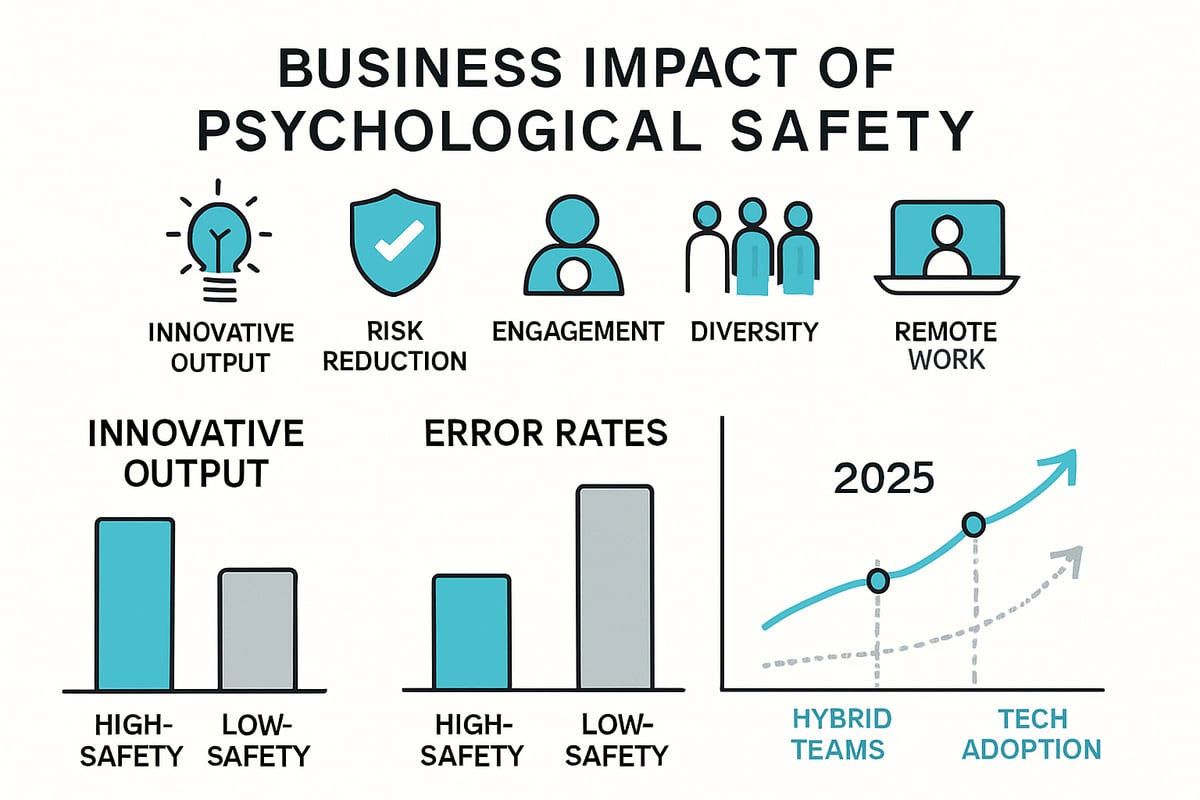
Impact on Team Performance and Innovation
At the core of edmondson psychological safety is the understanding that learning and innovation flourish where people feel safe to take risks. In healthcare, teams that reported more errors actually achieved better patient outcomes, because they were open about mistakes and learned from them. Tech giants like Google found psychological safety was the top predictor of team success in Project Aristotle.
Recent research shows that psychological safety boosts team efficacy and learning behaviors, leading to higher performance. For a deeper dive, see How Psychological Safety Affects Team Performance: Mediating Role of Efficacy and Learning Behavior.
When employees are not afraid to question, experiment, or share concerns, organizations unlock a wellspring of creative solutions and adaptability.
Error Reduction and Risk Management
High-stakes industries such as aviation, nuclear power, and healthcare have long embraced the edmondson psychological safety model to minimize risk. In these sectors, team members are encouraged to report near-misses and errors without fear of punishment. This transparency allows for swift interventions and prevents minor issues from escalating into disasters.
Organizations that prioritize psychological safety build a culture where error reporting is routine, not rare. This proactive approach saves resources, protects reputations, and supports long-term resilience. Leaders who foster psychological safety turn potential failures into opportunities for continuous improvement.
Employee Engagement, Retention, and Well-being
The link between edmondson psychological safety and employee engagement is powerful. When people feel safe at work, they are more likely to speak up, contribute ideas, and feel a sense of belonging. This translates directly to higher engagement and lower turnover.
Surveys reveal that 76% of employees who feel psychologically safe are more likely to stay with their employer. Well-being also improves, with reduced stress and burnout. Organizations that invest in psychological safety see lower absenteeism and greater loyalty, ultimately impacting the bottom line.
Diversity, Equity, and Inclusion (DEI) Alignment
Edmondson psychological safety is a key enabler for diversity, equity, and inclusion. In psychologically safe environments, all voices are welcomed, regardless of background or rank. This inclusion fosters diverse perspectives and robust debate, which are essential for innovation.
Studies show that companies excelling in DEI and psychological safety outperform peers in profitability and creativity. By embedding safety into their culture, organizations empower marginalized groups and drive equitable outcomes. DEI is not just a program—it thrives on a foundation of psychological safety.
The Cost of Ignoring Psychological Safety
Organizations that neglect edmondson psychological safety face steep consequences. Scandals, whistleblower cases, and high turnover rates are often rooted in cultures where people fear speaking up. The Wells Fargo sales scandal, for example, resulted in billions in fines and irreparable trust loss.
Financially, the costs are staggering: increased legal expenses, lost productivity, and damaged reputation. The absence of psychological safety can turn small issues into major crises, threatening organizational survival. Leaders must recognize that ignoring workplace trust is a high-risk gamble.
Trends for 2025 and Beyond
Looking ahead, edmondson psychological safety is only becoming more vital. Hybrid and remote work models introduce new challenges in building trust, as digital barriers can stifle open communication. Teams must adapt to rising complexity and uncertainty, requiring even greater resilience.
Regulatory expectations are also shifting, with psychological safety increasingly tied to ESG standards and workplace compliance. Organizations that prioritize psychological safety will attract top talent, stay ahead of risk, and maintain a competitive edge in a rapidly changing world.
Edmondson’s Framework: Steps to Building Psychological Safety
Unlocking the full potential of edmondson psychological safety requires intentional action at every level of an organization. Amy Edmondson’s framework offers a practical, step-by-step approach leaders can follow to weave psychological safety into the fabric of daily work. Let’s break down these essential steps for building a culture where trust, learning, and high performance thrive.
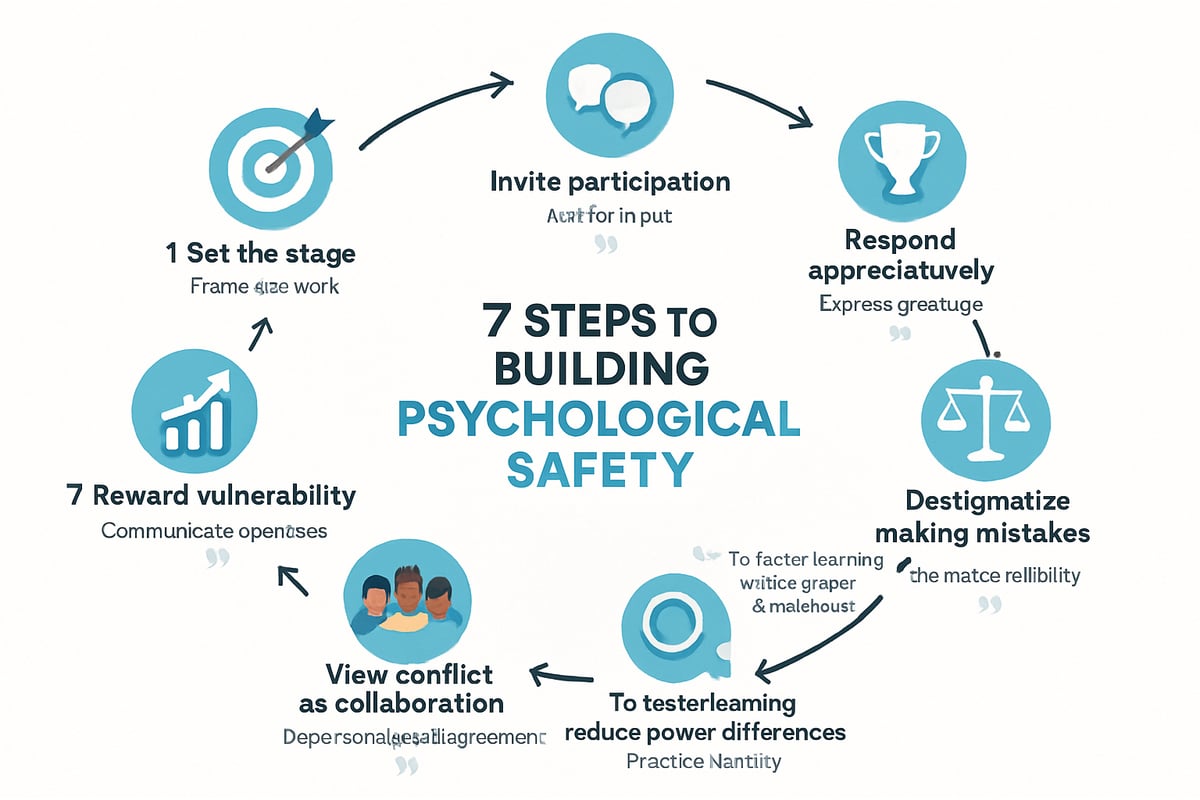
Step 1: Frame the Work and Set the Stage
The first step in edmondson psychological safety is setting a clear direction. Leaders must clarify shared goals and acknowledge the complexity and uncertainty of the work ahead. This open framing signals that mistakes are part of the process, not a source of blame.
For example, in healthcare, teams state the shared aim of patient safety upfront, inviting everyone to contribute. By framing the work this way, leaders create an environment where risk-taking and speaking up are expected. For a deeper dive into the stages of psychological safety, see The 4 Stages of Psychological Safety.
Step 2: Invite Participation and Input
Next, leaders need to actively invite input to build edmondson psychological safety. This means modeling vulnerability—admitting personal fallibility and asking for help or feedback. Leaders who say, “I might miss something, I need your input,” set a powerful example.
Practical techniques include:
- Regular check-ins where all voices are encouraged.
- Anonymous feedback tools for honest input.
- Open-door policies that lower barriers to communication.
When participation is truly invited, team members feel empowered to share insights and concerns.
Step 3: Respond Productively and Reward Speaking Up
A core principle of edmondson psychological safety is how leaders respond when someone takes the risk to speak up. Appreciation, not punishment, should be the default response. Leaders must act on feedback and close the loop, showing team members their voices matter.
Celebrating acts of courage—like raising a difficult issue—reinforces positive behavior. Recognition can be public, such as sharing success stories, or private, such as a simple thank you. Over time, this creates a culture where speaking up is not just accepted, but expected.
Step 4: Balance Accountability with Safety
Some believe edmondson psychological safety and high standards cannot coexist, but research proves otherwise. The healthiest teams hold each other accountable while maintaining trust and openness. Leaders avoid punitive measures that create fear, instead motivating through inspiration and clear expectations.
Consider using:
- Transparent performance metrics everyone can see.
- Constructive feedback focused on growth, not blame.
- Shared ownership of outcomes, reducing finger-pointing.
Balancing safety with accountability ensures top performance does not come at the cost of trust.
Step 5: Normalize and Learn from Failure
Teams embracing edmondson psychological safety treat failure as a learning opportunity. The goal is to replace blame with curiosity. High-performing teams conduct blameless post-mortems and error reviews, seeking to understand what happened and how to improve.
Key practices include:
- Regular debriefs after projects or incidents.
- Open discussions about what went wrong and why.
- Documenting lessons learned and sharing them widely.
This mindset shift turns setbacks into fuel for innovation and resilience.
Step 6: Foster Inclusion and Equity
True edmondson psychological safety cannot exist without inclusion. Leaders must actively address hierarchy and power dynamics, ensuring all voices—especially those of junior or marginalized team members—are heard.
Effective strategies:
- Rotate meeting facilitators to give everyone a chance to lead.
- Structured turn-taking so each person can contribute.
- Formal mentoring programs for underrepresented groups.
An equitable environment amplifies diverse perspectives and supports breakthrough thinking.
Step 7: Sustain and Scale Psychological Safety
Building edmondson psychological safety is not a one-time event; it requires ongoing commitment. Leaders should invest in continuous development, coaching, and measurement to keep safety alive as the organization grows.
Sustainability strategies:
- Use regular surveys and diagnostics to monitor team climate.
- Provide leadership coaching to reinforce desired behaviors.
- Set clear KPIs for safety, engagement, and retention.
Celebrating wins and sharing progress stories help maintain momentum.
Overcoming Barriers: Challenges and Solutions for Leaders
Creating a culture grounded in edmondson psychological safety is not without obstacles. Leaders often encounter deeply rooted barriers that can undermine trust and stifle open communication. To move from good intentions to real impact, organizations must first understand these challenges, then deploy targeted solutions for sustainable change.
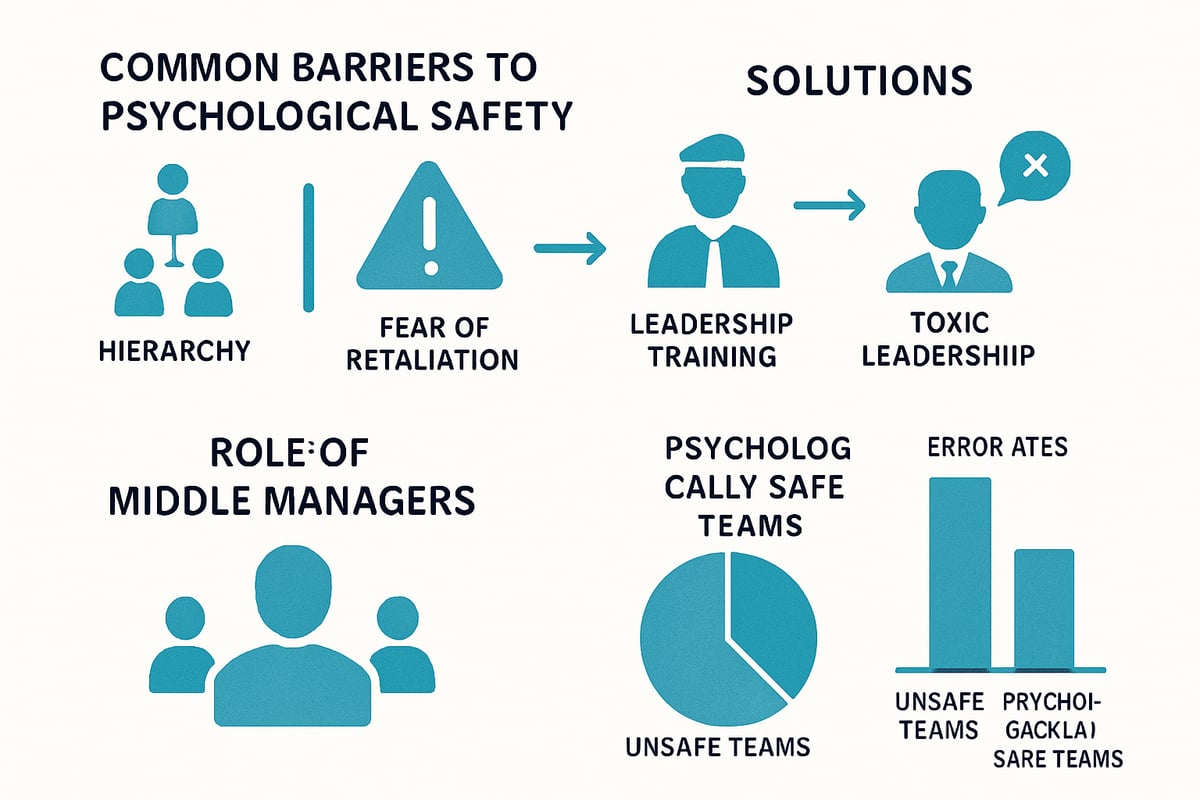
Common Obstacles to Psychological Safety
One of the most persistent barriers to edmondson psychological safety is hierarchical culture. In many organizations, power dynamics silence voices, especially those of junior staff or marginalized groups. Employees may hold back feedback or concerns because they fear retaliation or negative consequences.
Another obstacle is resistance to change. When old habits and entrenched behaviors dominate, new approaches to psychological safety struggle to take root. Misunderstandings about what psychological safety means can also derail progress, as some mistake it for comfort or a lack of accountability.
Leadership Blind Spots and Cultural Myths
Many leaders believe they are approachable and that their teams feel safe to speak up. However, research on edmondson psychological safety shows a stark contrast between leaders’ self-perception and team reality. Leadership blind spots can mask underlying issues, leaving problems unaddressed.
Cultural myths compound the challenge. The outdated idea that “strong leaders never admit mistakes” discourages vulnerability. In high-pressure environments like healthcare, junior staff often hesitate to question superiors, even when safety is at stake. These myths erode trust and hinder the open dialogue that edmondson psychological safety demands.
Practical Solutions and Interventions
To overcome these barriers, organizations need actionable interventions. Leadership training is essential for developing vulnerability and listening skills. Leaders who model transparency and humility help foster edmondson psychological safety within their teams.
Establishing clear, safe channels for reporting concerns is another critical step. Storytelling can be powerful, too. Sharing real examples of positive outcomes from speaking up illustrates the value of psychological safety. For organizations facing toxic cultures, Toxic Leader Transformation Strategies offer structured approaches to address harmful behaviors and rebuild trust.
Role of Middle Managers and Team Leads
Middle managers play a pivotal role in advancing edmondson psychological safety. They often serve as the daily gatekeepers of culture, bridging the gap between frontline employees and senior leadership. When empowered with the right tools and support, middle managers can model desired behaviors and reinforce safety at every interaction.
Supporting team leads with ongoing coaching and resources helps maintain consistency. Organizations that prioritize middle management development see greater adoption of psychological safety practices across departments, leading to stronger, more resilient teams.
Measurement and Accountability
Measuring progress is vital for sustaining edmondson psychological safety. Validated assessments, such as Edmondson’s Team Diagnostic Survey, offer insights into team dynamics and highlight areas for improvement. Regular feedback loops, including anonymous surveys and transparent reporting, ensure issues are addressed promptly.
Setting clear accountability standards allows organizations to track progress over time. By sharing results openly, leaders can celebrate wins, identify gaps, and continually reinforce the behaviors that underpin psychological safety.
Case Studies and Industry Examples
Industries with high reliability requirements, such as nuclear power, aviation, and healthcare, have successfully adapted edmondson psychological safety principles. These organizations conduct regular debriefs, encourage reporting of near-misses, and reward transparency. Lessons from failures, like the NASA Challenger disaster, underscore the high cost of ignoring psychological safety.
By learning from both success stories and setbacks, leaders can chart a path toward a safer, more innovative workplace.
Psychological Safety in Practice: Strategies for Implementation in 2025
Modern workplaces demand actionable strategies to bring edmondson psychological safety from theory into daily practice. Let’s explore proven approaches for fostering high trust, performance, and innovation, whether your team is hybrid, remote, or on-site.
Building Psychological Safety in Hybrid and Remote Teams
Hybrid and remote work environments introduce unique hurdles for edmondson psychological safety. The lack of face-to-face cues can hinder trust and open dialogue. Leaders must create virtual “safe spaces” for honest conversations by scheduling regular video meetings that prioritize check-ins and feedback.
Anonymous digital tools, such as online polls or suggestion boxes, can give every team member a voice without fear of negative consequences. Frequent pulse surveys help monitor team sentiment and flag issues early. Set clear expectations for communication so everyone knows how and when to speak up.
Embedding Psychological Safety into Organizational Culture
To make edmondson psychological safety a living part of your organization, it must be woven into daily routines and values. Integrate safety principles into onboarding, training, and performance reviews. Reinforce these behaviors by recognizing employees who model openness and learning.
Align psychological safety with DEI initiatives to foster inclusion. Encourage structured debate and reward constructive dissent. For an in-depth look at industry-specific examples, see Leadership in Manufacturing and Safety.
Tools, Frameworks, and Assessment Methods
Reliable measurement is essential for edmondson psychological safety. Use Edmondson’s Team Diagnostic Survey to assess team safety levels. Supplement with tools like the SCARF assessment or anonymous reporting platforms to track progress and uncover blind spots.
Create simple dashboards to visualize trends in engagement, error reporting, and innovation. Regularly share these insights with teams to drive ownership and improvement.
Leadership Development and Coaching
Sustaining edmondson psychological safety requires leaders who model vulnerability and openness. Structured leadership coaching programs build capabilities in active listening, feedback, and trust-building. Ongoing development ensures managers consistently reinforce safe behaviors.
Executive coaching for senior leaders helps embed these values from the top down. Peer coaching and mentoring also foster mutual support and learning across the organization.
Noomii Corporate Leadership Program: Enabling Sustainable Psychological Safety
Noomii’s evidence-based leadership coaching solutions help organizations address toxic behaviors and build trust at scale. Precision coach matching ensures leaders receive targeted support for edmondson psychological safety, accountability, and open communication.
Organizations can track improvements in culture, engagement, and leadership effectiveness. Noomii’s approach aligns with Edmondson’s principles by combining diagnostics, tailored interventions, and ongoing measurement. Trusted by government agencies and Fortune 500 companies, Noomii delivers sustainable workplace transformation.
Measuring Progress and Sustaining Momentum
Set clear KPIs for edmondson psychological safety, such as engagement scores, error rates, and retention. Use regular feedback loops and transparent reporting to share progress. Celebrate wins, no matter how small, to maintain motivation.
Share stories of employees who made a difference by speaking up or supporting a peer. Recognize that psychological safety is a journey, not a one-time fix.
Real-World Success Stories
Organizations that invest in edmondson psychological safety report fewer errors, higher innovation, and greater employee satisfaction. Manufacturing, healthcare, and tech companies have transformed cultures by embedding safety into every process.
The Future of Workplace Trust: Trends and Predictions for 2025
Imagine a future workplace where trust is not just encouraged but embedded in every process. As we look toward 2025, organizations that prioritize edmondson psychological safety will be best positioned to thrive in a rapidly changing world.
Evolving Leadership Models
The command-and-control approach is fading. Modern leaders embrace inclusivity, collaboration, and vulnerability. Empathy and openness are now seen as core strengths, not weaknesses. This evolution supports the principles of edmondson psychological safety, enabling teams to learn, adapt, and innovate faster than ever. Continuous learning and feedback loops are becoming the new standard for leadership excellence.
The Role of Technology and AI
Technology is transforming how organizations assess and build trust. Digital tools like real-time pulse surveys and anonymous feedback apps give employees a voice, regardless of location. AI-powered analytics can detect emerging issues in team dynamics, allowing leaders to intervene early. By integrating these advances, companies reinforce edmondson psychological safety and create transparent, responsive workplaces.
Psychological Safety as a Competitive Advantage
Organizations that champion psychological safety gain a distinct edge. They attract high-performing talent, foster creative problem-solving, and build resilience during disruption. As highlighted in Psychological Safety: The History, Renaissance, and Future of an Interpersonal Construct, this focus is now a top driver of innovation and sustained business success.
Regulatory and Compliance Implications
Workplace standards are evolving. Regulators increasingly recognize the value of edmondson psychological safety in reducing legal risks, such as harassment claims and whistleblower incidents. ESG reporting now often includes metrics on trust and inclusion. Organizations that ignore these shifts risk reputational damage and costly compliance failures in the years ahead.
Preparing for the Next Generation Workforce
Gen Z and Millennials expect transparency, fairness, and inclusion from their employers. They value workplaces where trust is the norm and psychological safety is built into the culture. To attract and retain this talent, leaders must embed these values into every layer of the organization, from onboarding to performance reviews.
Globalization and Cross-Cultural Challenges
As teams become more global, edmondson psychological safety frameworks must adapt to diverse cultural norms, languages, and communication styles. Leaders face the challenge of fostering trust across remote and multicultural teams. Addressing these barriers requires cultural sensitivity and a commitment to inclusive practices that resonate worldwide.
Call to Action for Leaders
The future of workplace trust depends on leaders who prioritize psychological safety. Invest in ongoing self-assessment, leverage resources like Rebuilding Team Trust in Workplaces, and commit to building trust at every level. For leaders ready to take the next step, explore the expert guidance at Accountability Now to drive measurable, lasting change.

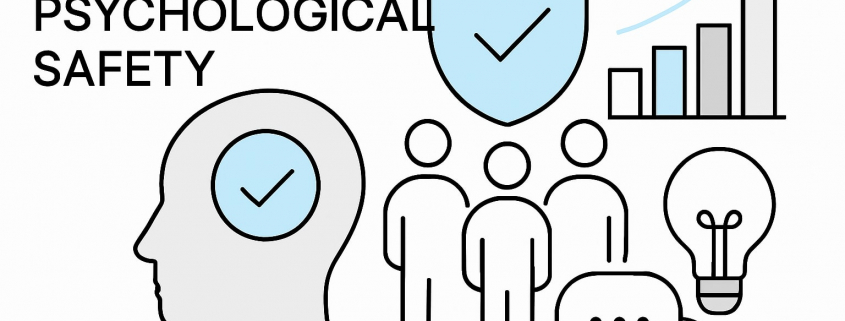


Leave a Reply
Want to join the discussion?Feel free to contribute!